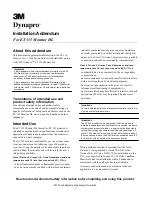
A-5
EPIM-F3
Table A-3. EPIM-F3 Specifications
Parameter
Typical
Minimum
Maximum
Transmitter Peak Wave Length
1300 nm
1270 nm
1330 nm
Spectral Width
60 nm
-
100 nm
Rise Time
3.0 nsec
2.7 nsec
5.0 nsec
Fall Time
2.5 nsec
2.2 nsec
5.0 nsec
Duty Cycle
50.1%
49.6%
50.7%
Bit Error Rate
Better than 10
-10
Transmitter Power decreases as temperatures rise and increases as
temperatures fall. Use the Output Power Coefficient to calculate increased or
decreased power output for your operating environment. For example, the
typical power output at 25° C is -16.4 dBm. For a 4° C temperature increase,
multiply the typical coefficient (-0.15 dBm) by four and add the result to typical
output power (4 x -0.15 dBm + -16.4 = -17.0).
NOTE
The transmitter power levels given above are Peak Power Levels after optical overshoot.
You must use a Peak Power Meter to correctly compare the values given above to those
measured on any particular port. If you are measuring power levels with an Average
Power Meter, add 3 dBm to the average power measurement to correctly compare the
average power values measured to the values listed above (i.e., -33.5 dBm a 3 dB
= -30.5 dBm peak).
NOTE
Summary of Contents for 9C306
Page 1: ...9031994 01 SmartSwitch 9000 6 Slot 9C306 System Monitor User s Guide...
Page 2: ......
Page 6: ...Notice iv...
Page 8: ...Contents vi...






































